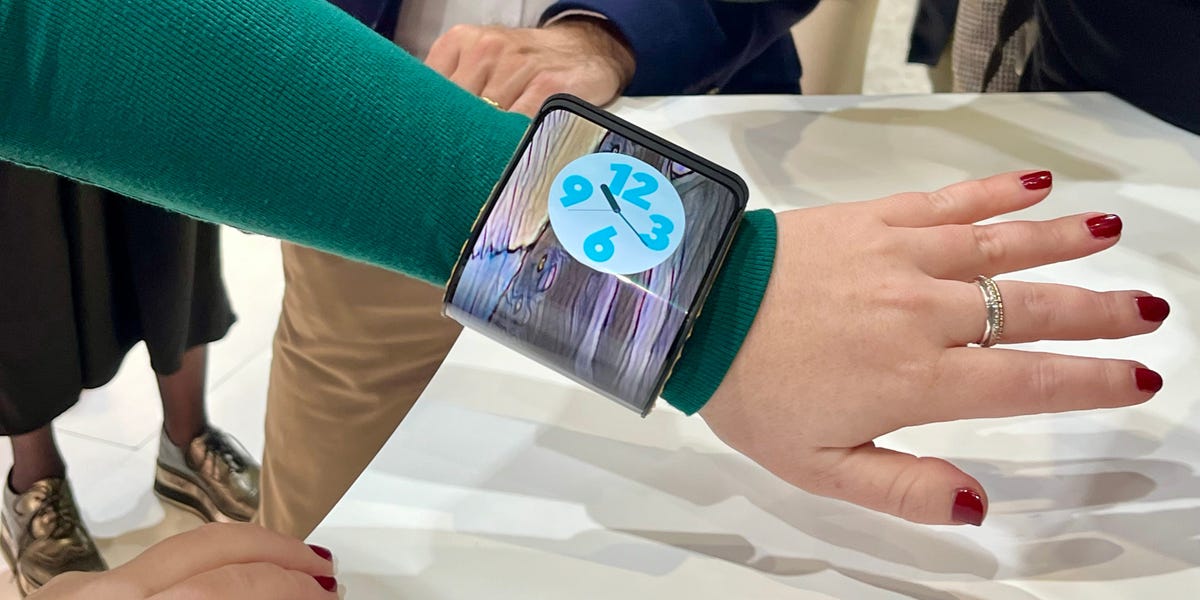- The AI boom and improved connectivity have created an opening for more experimentation in phones.
- Innovations are moving from concepts to devices we can buy.
- It’s time to make gadgets weird again.
- This article is part of “5G and Connectivity Playbook,” a series exploring some of our time’s most important tech innovations.
Our smartphones have never been so powerful, and so boring.
But there’s good news: It doesn’t have to be this way, and tech companies are taking some big swings at what the future of the phone could be.
Artificial-intelligence hype and gradual improvements in connectivity are inspiring companies to not only play with how things like generative AI can make our phones more interesting but also ask questions about what these gadgets in our pockets should look and feel like — and whether they should even sit in our pockets at all.
Why do our phones have to be rectangular blocks? Why can’t we wear our phones instead? Why do phones need apps? Do we even need screens?
At this year’s Mobile World Congress, the future of the smartphone and how we connect were firmly under the microscope. Companies have been showcasing weird and whacky concepts at shows like MWC and Las Vegas’s CES forever, but this year, some of these ideas seemed to be moving quickly to reality.
Deutsche Telekom and Brain.ai demoed one such instance at MWC: a smartphone with no apps. Instead, the user interacts with an AI assistant, which can do everything from texting friends to booking flights. It’s just an idea for now, but it’s prompting an interesting question: Why assume the smartphone of the future has apps at all?
Other companies think we need to dream a little bigger. Take Humane’s AI Pin, a wearable magnetic module that attaches to clothes and replicates many of your smartphone’s tasks. It has a camera, so it can see what’s happening around you, and instead of using a screen, it can project texts and images onto your hand.
The device, which is connected via LTE and houses an AI-powered assistant, attracted throngs of spectators eager to see it in action on the MWC floor.
Humane
The jury is still out on whether the buzz will translate to sales or good reviews: The pin won’t ship until April, and hands-on time with the gadget has been limited to highly controlled demos. It also costs $700.
But this is a well-funded company (its backers include OpenAI’s Sam Altman and Qualcomm) taking a new approach to the smartphone.
There’s also the Rabbit R1, another AI-powered handheld device, though this one does have a screen. Its creator says it isn’t going to replace your smartphone right away — but if it becomes a success, he thinks it might.
It’s a possibility because these devices are asking a valid question: If the smartphone were a truly personal AI assistant, what might it look like?
The answers will keep coming. Altman has enlisted Jony Ive, Apple’s former design chief, to help build new AI hardware devices, Bloomberg reported. Meanwhile, Meta’s Mark Zuckerberg is betting that augmented-reality glasses will be the primary device we’ll use in the future (though he doesn’t think they’ll necessarily kill the smartphone).
“With immersive computing, you’re going to start to rely less on the screen of the phone,” Carolina Milanesi, the president of the analyst firm Creative Strategies, told Business Insider.
“As we start to think about different form factors like glasses, looking at Meta and what they’re trying to do with AR and XR, there’s definitely an opportunity to share your compute experience across different devices,” Milanesi said.
Some ideas are more conceptual. Take Lenovo’s wearable phone, which bends around the wrist and uses some AI to match your clothing, or Lenovo’s transparent laptop screen, which may have generated the most headlines at MWC this year.
After speaking with Tom Butler, the executive director of Lenovo’s laptop line, I’m not convinced the company has a good reason for thinking people would use a transparent laptop — but it’s sure as hell fun to see it and talk about it.
“Sometimes we’re ahead of where the market is, so we showcase something like this, and it invokes conversation,” Butler said.
PAU BARRENA/AFP
A lot of these concepts will stay exactly as that — concepts — and some probably should (many of us would prefer to forget Will.i.am‘s disastrous Pulse Smartwatch, including, presumably, Will.i.am).
But the smartphone industry is slumping, and there’s a “need to invigorate the upgrade cycle,” Milanesi told BI. A collision of AI, 5G, and edge computing could be the perfect ingredients for companies to try out new ideas and, yes, sometimes get a bit weird.
It might not be a see-through display. But it could be something we wear or something that looks nothing like a rectangle covered in glass. Sometimes, as Lenovo’s Butler said, it’s just about starting the conversation.





